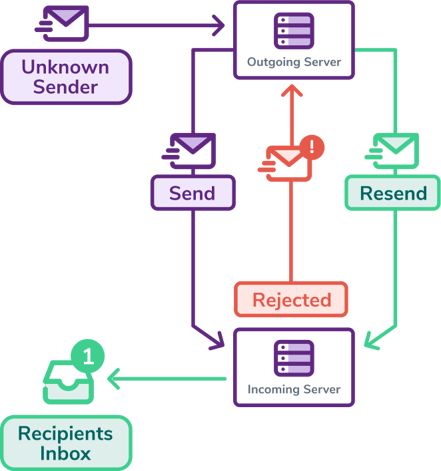How Anti-Greylisting Technology Impacts Email Validation
Email validators promise lower bounce rates, better conversions and better email deliverabilityⓘA sender’s ability to reach the recipient’s inbox with their outgoing emails. It may also describe the ratio of emails delivered to the inbox vs. those sent to spam or blocked by the receiving server..
You upload your list, click validate, and run into a problem - unknown results.
The culprit? Email greylisting.

To determine contact validity accurately, you need greylist countermeasures.
Before we talk about anti-greylisting's impact on email validation results, let's establish what greylisting is as our foundation.
What is greylisting?
Greylisting is a popular anti-spam technology that temporarily rejects email messages from unknown senders. Most greylisting is time-based, meaning they only block messages for a specified duration - usually 15 minutes.
The recipient server issues a 4xx status code during this window, indicating a temporary issue. A legitimate, well-configured mail server will anticipate this and reattempt delivery before bouncing back. After the greylisting period elapses, the recipient server accepts the message and directs it to the inbox.
Once the delivery is successful, the receiving mail server remembers the address and marks it as a safe, trusted sender.
Greylisting
How greylisting negatively impacts email validation
While greylisting is necessary for spam prevention, it makes email validation tricky.
The email validation service solicits a response from the recipient’s email server to validate an address. After the process, it marks the address as valid or invalid based on the results.
However, with email greylisting in place, the server temporarily rejects the incoming attempt as it would with a real email message. The validation result comes back as “unknown” as the service cannot verify one way or the other.
Unknown results won’t tell you anything. An email validator needs to inform you whether or not an address is valid. This is particularly frustrating because many email addresses on your list that feature email greylist checks are valid, active leads.
Are your emails valid? Ditch unknown results and use ZeroBounce’s anti-greylisting email verifier now!
Verify Your Emails FreeBeyond that, you need to know if an email address is potentially harmful (abuse emails, catch-alls, etc.). Without a way to circumvent greylisting, your email verifier isn’t as useful as it could be.
How to bypass greylisting when using an email validator
The most effective way to avoid greylisting is to use an email verifier with anti-greylisting technology. This allows the email validator to behave similarly to a well-configured email server.
Here’s how it works.
1. To avoid greylisting, brands appropriately configure their Simple Mail Transfer Protocol (SMTP). This allows messages to remain in the queue when receiving a 4xx reply code from the recipient server.
2. Instead of bouncing, the message remains in the queue for the necessary duration, usually 15 minutes.
3. Once the period expires, the sending server re-attempts delivery and is successful.
This anti-greylist solution allows an email validator to achieve the same result. Whenever you enter an email address for validation, the tool provides greylist mitigation and will continue to retry until it obtains an accurate result.
With this greylist bypass method, you will drastically reduce the number of unknown results you obtain when validating your list. You maintain the greatest level of control of your email list health and the performance of your campaigns.
Try these free email deliverability calculators
Additional greylist avoidance strategies
While ZeroBounce’s anti-greylisting technology helps with your validation results, greylisting can still impact your email deliverability.
To help with greylist mitigation, be sure to monitor the following regularly:
- Your SMTP configuration - Incorrectly configuring your email server prevents message delivery. Check your configuration to help avoid greylisting.
- Your email sender scoreⓘOften used interchangeably with Sender Reputation. It is a score used by internet service providers to communicate your reputation with others based on your historical email-sending habits and behaviors. - Email servers want to stop messages from untrustworthy senders. Maintain your email reputationⓘAlso referred to as ‘Sender Reputation.’ This describes how trustworthy a sender is when sending emails. Reputation is influenced by past campaign performance and sending habits, including bounce rate, spam complaints, abuse reports, email authentication, sending volume, and domain history. to assist with greylisting prevention.
- Best email practices - Optimizations like clean titles, preview text, an unsubscribe button, and a reply-to address work wonders as greylist bypass methods.
- SPF, DMARC and DKIM - Configuring your email server with the appropriate records allow email servers to confirm your domain identity. Not only do they better secure your domain, but they serve as effective greylist countermeasures.
Contents
- to find more details about links
- What is greylisting? to find more details about links
- How greylisting negatively impacts email validation to find more details about links
- How to bypass greylisting when using an email validator to find more details about links
- Additional greylist avoidance strategies to find more details about links
Frequently asked questions
Email greylisting aims to protect users from incoming spam. Temporarily rejecting messages from unknown senders reduces the amount of spam that reaches the inbox or spam folder.
Email servers greylist emails to protect users from spam and malicious content. They temporarily reject messages from all unknown senders.
Legitimate senders typically configure their SMTP to re-attempt delivery before hard bouncing. This provides greylisting prevention for legitimate senders and filters out the spammers that fail to use anti-greylisting techniques.
Yes.
The most commonly used email greylist check is time-based. Receiving servers reject mail from unknown senders for fifteen minutes. A well-configured email server should anticipate this and deploy anti-greylisting techniques to avoid hard bounces.
Spammers simply mass-target inboxes and will not wait out the rejection period. They’re more interested in discovering vulnerable domains rather than optimizing their deliverability. Thus, greylisting helps to filter out unwanted messages.
Greylisting is tremendously effective at stopping malicious senders. This protects you from phishing attempts, malware, viruses and other types of spam. Greylisting is a terrific solution that can protect your data.
The downside of greylisting is that it delays legitimate email content. If you need content to reach readers immediately, greylisting may negatively impact results. In certain circumstances, valid emails can take longer than fifteen minutes to hit the inbox or be lost entirely.
You’ll need to carefully assess your email needs and determine the value of protection versus the impact of possible messaging delays.
The only perceived downside to using this anti-greylisting solution is that it takes longer to receive your email validation results. However, the importance of obtaining accurate results is far greater than a temporary delay.
Remember - the time delay occurs due to the greylisting check present on an email server. Our technology allows you to determine if an email address is valid or harmful instead of sending back an “unknown” result. Spam prevention tactics will always be present, so you must use greylist avoidance strategies for your email marketing.
An email greylist check temporarily rejects messages from an email domain or IP. It’s an anti-spam technology that blocks would-be malicious senders while still allowing legitimate senders to connect with your inbox.
An email blacklist indefinitely blocks incoming messages from an email domain or IP. You might be on an email server’s personal blacklist or another list operated by public blacklisting services. If you are on a blacklist, your content will never reach the inbox.
You may find yourself on an email blacklist if:
- Your sender reputation is low
- You have a history of spam reports / spammy content
- You emailed a spam trap
